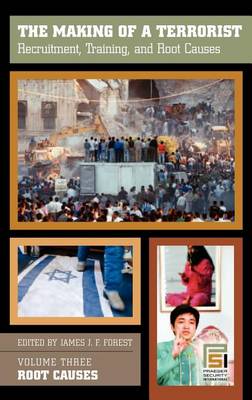Praeger Security International
6 total works
Homeland Security [Three Volumes]: Protecting America's Targets
by James J F Forest
Global terrorism has become a frightening reality. From New York City and Washington, D.C., to Bali, Moscow, and Madrid, ordinary citizens throughout the civilized world live with increasing fear of a deadly attack from unknown individuals, for reasons many of us cannot fathom. National and international security forces are on constant alert, desperate to prevent the next catastrophe, and yet many observers agree that our military and intelligence services are spread too thin and face insurmountable hurdles in the global war on terrorism. The situation calls for greater engagement with the public, as the necessary eyes and ears of the global anti-terrorism coalition. However, to be effective the public must be equipped with the knowledge of how, why, and where an individual becomes a terrorist. This is the primary goal of this set, which seeks to answer one central question: What do we currently know about the transformation through which an individual becomes a terrorist?
Overall, we have learned that the transformation through which an individual becomes a terrorist involves a variety of complex and intertwined issues. A single contributing factor-such as personal religious conviction, widespread poverty, or an oppressive government-may not necessarily lead to the formation of terrorist organizations. However, the current body of research on terrorism suggests that a combination of factors will, in most cases, result in some form of terrorism. This combination differs widely by region, and at minimum involves motivations, opportunities, contexts, processes, personal disposition, and preparation. Volume I deals with recruitment means and methods, and includes discussions of psychological, social, ideological, and religious dimensions of recruitment. Volume II addresses the training of terrorists, including teaching tools and training manuals, and it includes fascinating case studies from Al Qaeda, Hezbollah, Aum Shinrikyo, Christian militias, and other groups. Volume III is devoted to root causes, including their political, religious, and socioeconomic dimensions. Appendices to these volumes feature profiles of terrorist organizations, samples of terrorist training manuals, and recommended resources for the study of terrorism.
This important work, edited by an expert on terrorism, focuses on the 21st-century struggle for strategic influence and ways in which states can neutralize the role of new media in spreading terrorist propaganda.
In an era where anyone can have access to the Internet or other media forms that make widespread communication easy, terrorists and insurgents can spread their messages with complete freedom, creating challenges for national security. Influence Warfare: How Terrorists and Governments Fight to Shape Perceptions in a War of Ideas focuses on the core of the ongoing struggle for strategic influence and, particularly, how states can counter the role media and the Internet play in radicalizing new agents of terrorism.
As the book makes clear, governments need to find ways to effectively confront non-state adversaries at all levels of the information domain and create an understanding of strategic communications within a broad range of technologies. The essays from the international group of authors who contributed to this work offer a deeper understanding of the ongoing struggle. Influence Warfare also provides a set of case studies that illustrate how the means and methods of strategic influence can impact a nation's security.
- Case studies
America is a target; the homeland is under threat. While Americans have been targets of terrorist attacks for quite some time, September 11, 2001, awoke the nation to the reality that we are vulnerable in our homes, our places of work and worship, and our means of public transportation. And yet, we must continue to function as best we can as the world's most vibrant economic and political community. The current threat environment requires greater engagement with the public, as the necessary eyes and ears of the nation's homeland security infrastructure. However, to be effective, the public must be equipped with the knowledge of where and why specific locations and activities may be a terrorist target, what is being done to protect those targets, and how they can help. This three-volume set answers that need.
The chapters of each volume of Homeland Security revolve around a core of central questions. Are we safer today than we were pre-9/11? What steps have been taken in all these areas to protect ourselves? What are the threats we face, and what new threats have developed since 9/11? Are we staying one step ahead of those who wish to do us harm? In 2002, more than 400 million people, 122 million cars, 11 million trucks, 2.4 million freight cars, and 8 million containers entered the United States. Nearly 60,000 vessels entered the United States at its 301 ports of entry. Clearly the amount of activity this represents will require a long-term commitment to innovation, organizational learning, and public vigilance to complement an already overstretched network of government agencies and security professionals.
Volume 1, Borders and Points of Entry, addresses the question of how and where harmful people or material can enter the country, and how a combination of local, state, and federal agencies work with the private sector to ensure our security.
Volume 2, Public Spaces and Social Institutions, covers a wide variety of potential vulnerabilities.
Volume 3, Critical Infrastructure, deals with vital infrastructures and systems, attacks against which would yield not only significant loss of life but would also entail devastating economic and financial consequences.
This timely book spotlights how various entities are using the Internet to shape people's perceptions and decision-making. It also describes detailed case studies as well as the tools and methods used to identify automated, fake accounts.
This book brings together three important dimensions of our everyday lives. First is digital-the online ecosystem of information providers and tools, from websites, blogs, discussion forums, and targeted email campaigns to social media, video streaming, and virtual reality. Second, influence-the most effective ways people can be persuaded, in order to shape their beliefs in ways that lead them to embrace one set of beliefs and reject others. And finally, warfare-wars won by the information and disinformation providers who are able to influence behavior in ways they find beneficial to their political, social, and other goals.
The book provides a wide range of specific examples that illustrate the ways people are being targeted by digital influencers. There is much more to digital influence warfare than terrorist propaganda, "fake news," or Russian efforts to manipulate elections: chapters examine post-truth narratives, fabricated "alternate facts," and brainwashing and disinformation within the context of various political, scientific, security, and societal debates. The final chapters examine how new technical tools, critical thinking, and resilience can help thwart digital influence warfare efforts.
- Integrates interdisciplinary perspectives from security studies, psychology, sociology, criminology, information technology, and several other fields of study
- Examines the ways in which terrorists, governments, politicians, corporations, and many others use online technology to influence beliefs and behaviors
- Offers detailed case studies to illustrate how people succumb to the digital influence warfare efforts of governments, terrorists, politicians, corporations, and others
- Explains the tools and methods used to identify automated, fake accounts on social media ("bots") as well as efforts to delete or suspend users for offensive content or attempts to spread disinformation
- Provides clear explanations of technical terms and tools used by those who engage in these digital influence efforts
![Cover of Homeland Security [Three Volumes]: Protecting America's Targets](https://static.bookhype.com/assets/images/book-cover-dark.png)
![Cover of The Making of a Terrorist [3 volumes]](https://images.bookhype.com/covers/07/67/91575044-5db7-4c87-802c-b4e9cf127670/9780275985431-4c649b9f6c4fa989f0b916.jpg)


![Cover of Homeland Security [3 volumes]](https://images.bookhype.com/covers/09/d2/91576f7b-7ed5-427f-8110-985c32752d90/9780275987688-67af41bbecf1d25e0aa1fd.jpg)
